三年级上册英语教案-Module 7 Unit 1 Have you got a headache 2|外研社(一起)
小学英语新外研版(一起)三年级上册新标准M7U1《Have you got a headache?》教案第二课时
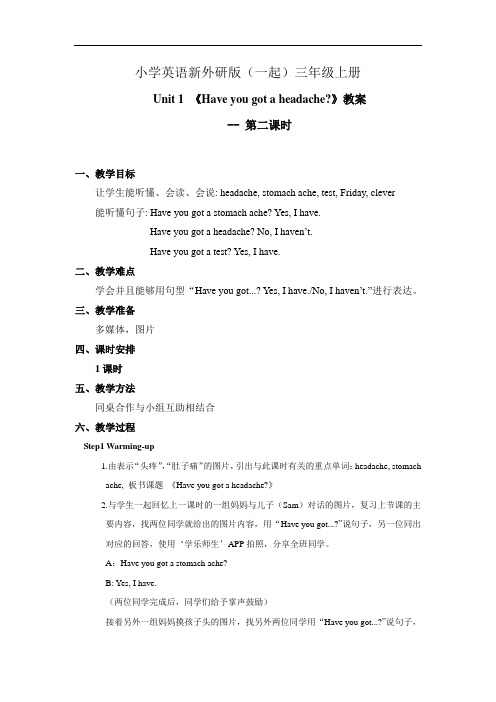
小学英语新外研版(一起)三年级上册Unit 1 《Have you got a headache?》教案--第二课时一、教学目标让学生能听懂、会读、会说: headache, stomach ache, test, Friday, clever能听懂句子: Have you got a stomach ache? Yes, I have.Have you got a headache? No, I haven’t.Have you got a test? Yes, I have.二、教学难点学会并且能够用句型“Have you got...? Yes, I have./No, I haven’t.”进行表达。
三、教学准备多媒体,图片四、课时安排1课时五、教学方法同桌合作与小组互助相结合六、教学过程Step1 Warming-up1.由表示“头疼”,“肚子痛”的图片,引出与此课时有关的重点单词:headache, stomachache, 板书课题《Have you got a headache?》2.与学生一起回忆上一课时的一组妈妈与儿子(Sam)对话的图片,复习上节课的主要内容,找两位同学就给出的图片内容,用“Have you got...?”说句子,另一位同出对应的回答,使用‘学乐师生’APP拍照,分享全班同学。
A:Have you got a stomach ache?B: Yes, I have.(两位同学完成后,同学们给予掌声鼓励)接着另外一组妈妈摸孩子头的图片,找另外两位同学用“Have you got...?”说句子,C:Have you got a headache?D:No, I haven’t.Step2 Text learning1.Text learningListen to the tape and do as you are told to do(听录音,按照要求做)。
小学英语新外研版(一起)三年级上册Module7 unit1《Have you got a h…… (3)教案
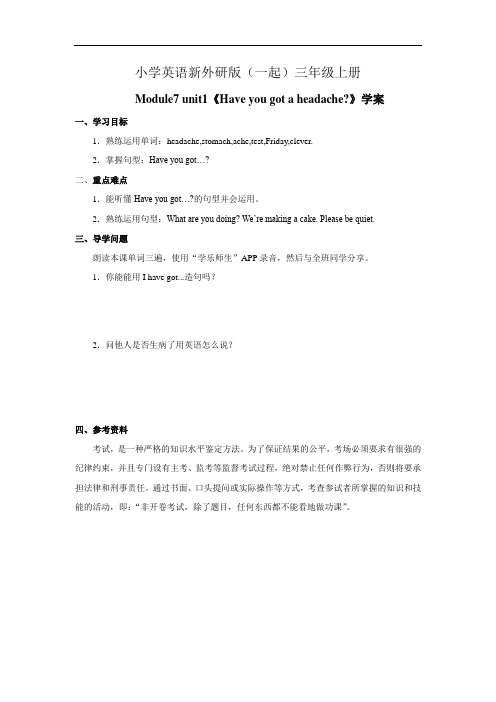
小学英语新外研版(一起)三年级上册
Module7 unit1《Have you got a headache?》学案
一、学习目标
1.熟练运用单词:headache,stomach,ache,test,Friday,clever.
2.掌握句型:Have you got…?
二、重点难点
1.能听懂Have you got…?的句型并会运用。
2.熟练运用句型:What are you doing? We’re making a cake. Please be quiet.
三、导学问题
朗读本课单词三遍,使用“学乐师生”APP录音,然后与全班同学分享。
1.你能能用I have got...造句吗?
2.问他人是否生病了用英语怎么说?
四、参考资料
考试,是一种严格的知识水平鉴定方法。
为了保证结果的公平,考场必须要求有很强的纪律约束,并且专门设有主考、监考等监督考试过程,绝对禁止任何作弊行为,否则将要承担法律和刑事责任。
通过书面、口头提问或实际操作等方式,考查参试者所掌握的知识和技能的活动,即:“非开卷考试,除了题目,任何东西都不能看地做功课”。
外研版一起点三年级英语上册《Have you got a headache》教学设计
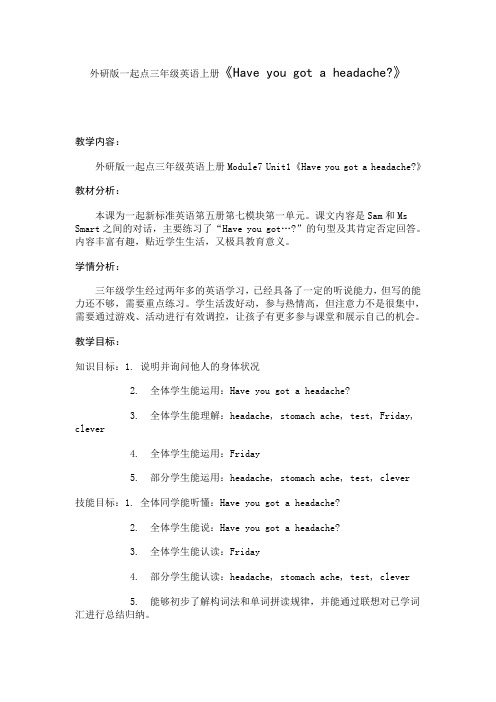
外研版一起点三年级英语上册《Have you got a headache?》教学内容:外研版一起点三年级英语上册Module7 Unit1《Have you got a headache?》教材分析:本课为一起新标准英语第五册第七模块第一单元。
课文内容是Sam和Ms Smart之间的对话,主要练习了“Have you got…?”的句型及其肯定否定回答。
内容丰富有趣,贴近学生生活,又极具教育意义。
学情分析:三年级学生经过两年多的英语学习,已经具备了一定的听说能力,但写的能力还不够,需要重点练习。
学生活泼好动,参与热情高,但注意力不是很集中,需要通过游戏、活动进行有效调控,让孩子有更多参与课堂和展示自己的机会。
教学目标:知识目标:1. 说明并询问他人的身体状况2. 全体学生能运用:Have you got a headache?3. 全体学生能理解:headache, stomach ache, test, Friday, clever4. 全体学生能运用:Friday5. 部分学生能运用:headache, stomach ache, test, clever技能目标:1. 全体同学能听懂:Have you got a headache?2. 全体学生能说:Have you got a headache?3. 全体学生能认读:Friday4. 部分学生能认读:headache, stomach ache, test, clever5. 能够初步了解构词法和单词拼读规律,并能通过联想对已学词汇进行总结归纳。
情感目标:1. 了解英语中简单的病症表达方式,以及西方人在谈论身体状况时的交谈礼仪。
2. 树立正确的健康观念,关心他人的身体状况。
教学重难点:询问对方有没有生病的句型及其肯否定回答:Have you got…? Yes, I have. No, I haven’t.教具:幻灯片,单词卡片,CD光盘教学过程:一、问候:Hello, boys and girls. How are you today?二、热身:First let’s sing a song《Head, shoulders, knees and toes》【评析】通过唱歌,来复习身体部位的单词:ear, eye, head, 新授stomach三、导入:学习ache这个词缀,简单介绍构词法,学习新单词headache, stomach ache。
小学英语新外研版(一起)三年级上册新标准M7 U1《Have you got a headache?》教案第一课时
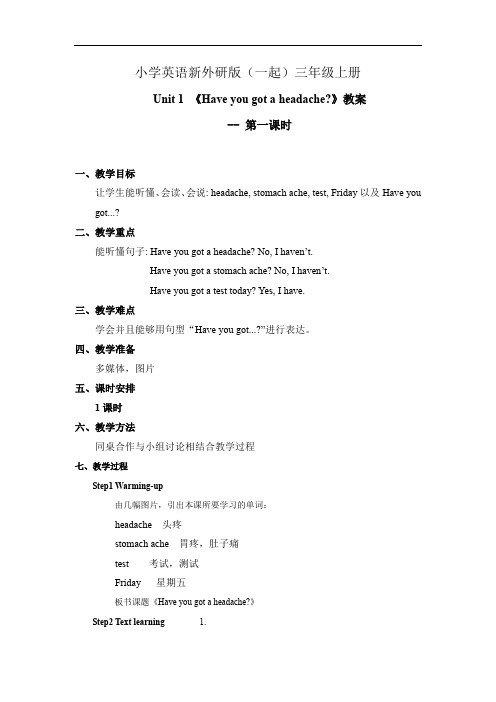
小学英语新外研版(一起)三年级上册Unit 1 《Have you got a headache?》教案--第一课时一、教学目标让学生能听懂、会读、会说: headache, stomach ache, test, Friday以及Have you got...?二、教学重点能听懂句子: Have you got a headache? No, I haven’t.Have you got a stomach ache? No, I haven’t.Have you got a test today? Yes, I have.三、教学难点学会并且能够用句型“Have you got...?”进行表达。
四、教学准备多媒体,图片五、课时安排1课时六、教学方法同桌合作与小组讨论相结合教学过程七、教学过程Step1 Warming-up由几幅图片,引出本课所要学习的单词:headache 头疼stomach ache 胃疼,肚子痛test 考试,测试Friday 星期五板书课题《Have you got a headache?》Step2 Text learning 1.1. Listen and say. (听,说)(使用‘学乐师生’APP录音,分享全班同学)Listen to the tape for two times, then ask two students to repeat it.Sam:I am hungry.Mum: Have you got stomach ache?Sam: Yes, I have.引出了本课的重点句子:Have you got...? Yes, I have.2. Text learningListen, point and find“Have you got...?”(听,指和找到“Have you got...?的句子)听录音跟读(使用‘学乐师生’APP录音,分享给全班同学。
三年级上册英语教案-Module7Unit1Haveyougotaheadache2|外研社(一起)

三年级上册英语教案Module 7 Unit 1 Have you got aheadache 2|外研社(一起)教学目标1. 让学生能够听懂、会说、会读本课的重点单词和句子,如headache, stomach ache, toothache等。
2. 培养学生运用所学句型询问和描述身体不适的能力。
3. 培养学生的合作意识和交际能力。
4. 培养学生关心他人,乐于助人的品质。
教学内容1. 单词:headache, stomach ache, toothache, fever,earache2. 句型: Have you got a headache? Yes, I have. / No, I haven't.教学重点与难点1. 教学重点:掌握本课单词和句型,能够运用所学知识询问和描述身体不适。
2. 教学难点:正确发音单词和句型,熟练运用所学知识进行交际。
教具与学具准备1. 教具:多媒体课件、图片、单词卡片2. 学具:学生用书、练习本教学过程1. 热身活动:唱英文歌曲,营造轻松愉快的学习氛围。
2. 引入新课:展示图片,引导学生说出身体部位的名称,进而引出本课单词。
3. 学习单词:教师领读单词,学生跟读,然后进行小组活动,巩固单词。
4. 学习句型:教师示范句型,学生跟读,然后进行角色扮演,练习句型。
5. 小组活动:学生分组,用所学句型询问和描述身体不适,加强交际能力。
6. 巩固练习:完成练习册上的相关练习,巩固所学知识。
板书设计1. Module 7 Unit 1 Have you got a headache?2. 重点单词和句型作业设计1. 抄写本课单词和句型2. 用所学句型编写对话,询问和描述身体不适3. 家长签字,确保作业完成质量课后反思本节课通过图片、歌曲、角色扮演等多种教学手段,激发了学生的学习兴趣,提高了学生的参与度。
在教学过程中,注重学生的听说训练,使学生在轻松愉快的氛围中掌握了所学知识。
小学英语新外研版(一起)三年级上册Module7 unit1《Have you got a h…… (2)教案
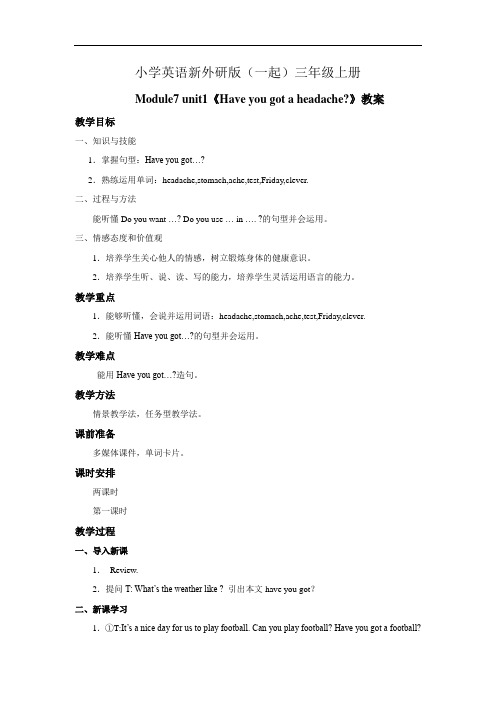
小学英语新外研版(一起)三年级上册Module7 unit1《Have you got a headache?》教案教学目标一、知识与技能1.掌握句型:Have you got…?2.熟练运用单词:headache,stomach,ache,test,Friday,clever.二、过程与方法能听懂Do you want …? Do you use … in …. ?的句型并会运用。
三、情感态度和价值观1.培养学生关心他人的情感,树立锻炼身体的健康意识。
2.培养学生听、说、读、写的能力,培养学生灵活运用语言的能力。
教学重点1.能够听懂,会说并运用词语:headache,stomach,ache,test,Friday,clever.2.能听懂Have you got…?的句型并会运用。
教学难点能用Have you got…?造句。
教学方法情景教学法,任务型教学法。
课前准备多媒体课件,单词卡片。
课时安排两课时第一课时教学过程一、导入新课1.Review.2.提问T: What’s the weather like ? 引出本文have you got?二、新课学习1.①T:It’s a nice day for us to play football. Can you play football? Have you got a football?Have you got…? Yes, I have. No, I haven’t.②It’s so cold. Look ! I have got a sweater. Have you got a sweater?Have you got ...? Ye s, I have. No, I haven’t.(准备两套方案。
如果天气好,就通过说是个踢足球的好天气,询问学生会踢足球吗,有足球吗,引出句型Have you got ...? 即肯定和否定回答Yes, I have. No, I haven’t. 如果天气不好,通过说老师自己有件毛衣,来问学生有没有毛衣,从而引出句型Have you got ...? ) 2.Explain and practice “Have you got…? Yes, I have. No, I haven’t.” (集体说,个别提问,让学生既掌握句型的含义,又能熟练问答)3.①T: Have you got a book/ a pencil box …?Ss:.......(可以通过问男孩、女孩有没有连衣裙,从而肯定和否定回答都能练到。
Module 7 Unit 1 Have you got a headache(教案)-2022-2
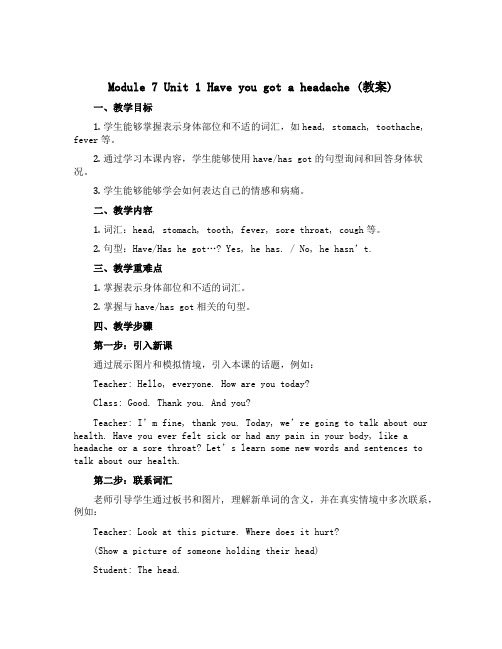
Module 7 Unit 1 Have you got a headache (教案)一、教学目标1.学生能够掌握表示身体部位和不适的词汇,如head, stomach, toothache, fever等。
2.通过学习本课内容,学生能够使用have/has got的句型询问和回答身体状况。
3.学生能够能够学会如何表达自己的情感和病痛。
二、教学内容1.词汇:head, stomach, tooth, fever, sore throat, cough等。
2.句型:Have/Has he got…? Yes, he has. / No, he hasn’t.三、教学重难点1.掌握表示身体部位和不适的词汇。
2.掌握与have/has got相关的句型。
四、教学步骤第一步:引入新课通过展示图片和模拟情境,引入本课的话题,例如:Teacher: Hello, everyone. How are you today?Class: Good. Thank you. And you?Teacher: I’m fine, thank you. Today, we’re going to talk about our health. Have you ever felt sick or had any pain in your body, like a headache or a sore throat? Let’s learn some new words and sentences to talk about our health.第二步:联系词汇老师引导学生通过板书和图片, 理解新单词的含义,并在真实情境中多次联系,例如:Teacher: Look at this picture. Where does it hurt?(Show a picture of someone holding their head)Student: The head.Teacher: That’s right, the head. And what do we call it when we have pain in our head?Student: A headache.Teacher:好,那头疼用英文怎么说?Student: Headache.Teacher: Great job! Now let’s pract ice some more.第三步:学习句型在理解了新单词后,老师引导学生学习如何使用句型构建问题和回答,例如:Teacher: Now that we’ve learned some new words, let’s learn how to ask and answer questions about our health. Look at this picture. What’s wrong with her?(Show a picture of someone holding their stomach)Student: Her stomach hurts.Teacher: Yes, she has a stomachache. Now, let’s practice asking and answering questions with。
最新外研英语一起三年级上册Module 7 Unit 1 学案
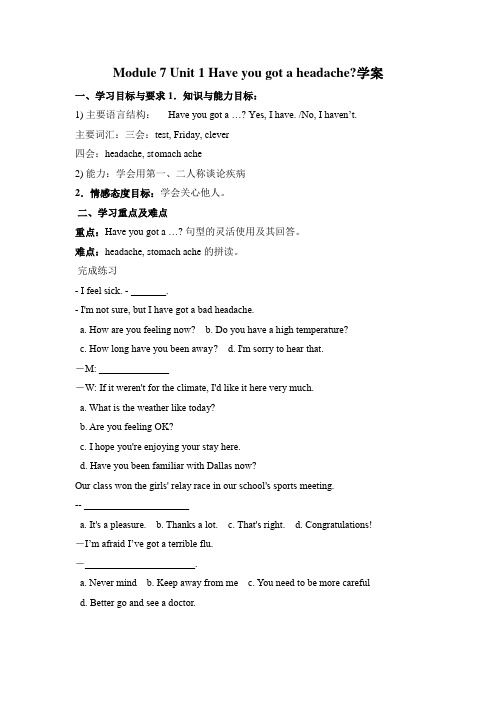
Module 7 Unit 1 Have you got a headache?学案一、学习目标与要求1.知识与能力目标:1) 主要语言结构:Have you got a …? Yes, I have. /No, I haven’t.主要词汇:三会:test, Friday, clever四会:headache, stomach ache2) 能力:学会用第一、二人称谈论疾病2.情感态度目标:学会关心他人。
二、学习重点及难点重点:Have you got a …?句型的灵活使用及其回答。
难点:headache, stomach ache的拼读。
完成练习- I feel sick. - _______.- I'm not sure, but I have got a bad headache.a. How are you feeling now?b. Do you have a high temperature?c. How long have you been away?d. I'm sorry to hear that.-M: ______________-W: If it weren't for the climate, I'd like it here very much.a. What is the weather like today?b. Are you feeling OK?c. I hope you're enjoying your stay here.d. Have you been familiar with Dallas now?Our class won the girls' relay race in our school's sports meeting.-- _____________________a. It's a pleasure.b. Thanks a lot.c. That's right.d. Congratulations! -I’m afraid I’ve got a terrible flu.-______________________.a. Never mindb. Keep away from mec. You need to be more carefuld. Better go and see a doctor.。
小学英语新外研版(一起)三年级上册Module7 unit1《Have you got a h……

作业布置
1.Survey 对你的三个朋友做个调查,看 看你的玩具他们都有没有。 2.抄写下列单词每个5遍: headache,stomach,ache,test,Friday,clever
板书设计
Module7 unit1 Have you got a headache? headache,stomach,ache,test,Friday,clever. Have you got…?
The En
d
精品课件
小学英语新外研版(一起) 三年级上册
市实小 清风制作
外研新标准小学英语三年级上册
Module 7 Unit 1
朗读本课单词三遍,使用“学乐师生”APP录 音,然后与全班同学分享。
导入新课
unit 1 Have you got a headache?
新课学习
I am hungry.
新课学习
新课学习
胃痛,中医病证名。多由外感寒邪、饮 食所伤、情志不畅和脾胃素虚等病因而引 发。胃是主要病变脏腑,常与肝脾等脏有 密切关系。胃气郁滞、失于和降是胃痛的 主要病机。治疗以理气和胃为大法,根据 不同证候,采取相应治法。
新课学习
头痛(headache) 是临床常见的症状,通常 将局限于头颅上半部,包括眉弓、耳轮上缘和枕 外隆突连线以上部位的疼痛统称头痛。头痛病因 繁多,神经痛、颅内感染、颅内占位病变、脑血 管疾病、颅外头面部疾病、以及全身疾病如急性 感染、中毒等均可导致头痛。发病年龄常见于青 年、中年和老年。
I am cold.
新课学习
stomach ache
新课学习
I am ill.
新课学习
test
新课学习
clever
三年级英语上册Module 7 Unit 1 Have you got a headache 教案 外研版一起
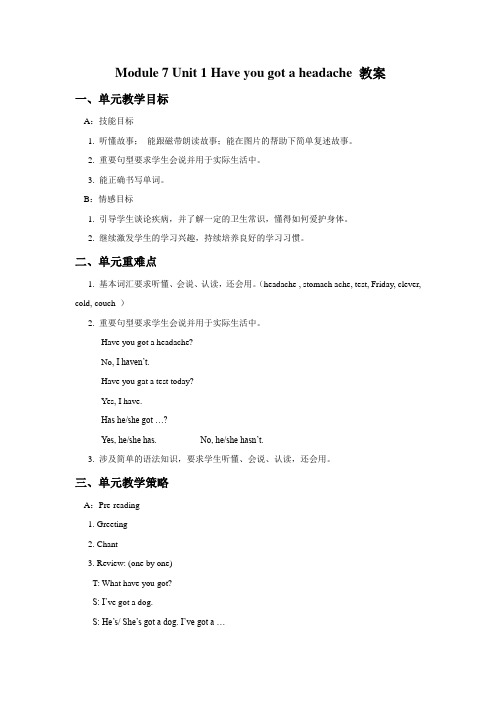
Module 7 Unit 1 Have you got a headache 教案一、单元教学目标A:技能目标1. 听懂故事;能跟磁带朗读故事;能在图片的帮助下简单复述故事。
2. 重要句型要求学生会说并用于实际生活中。
3. 能正确书写单词。
B:情感目标1. 引导学生谈论疾病,并了解一定的卫生常识,懂得如何爱护身体。
2. 继续激发学生的学习兴趣,持续培养良好的学习习惯。
二、单元重难点1. 基本词汇要求听懂、会说、认读,还会用。
(headache , stomach ache, test, Friday, clever, cold, couch )2. 重要句型要求学生会说并用于实际生活中。
Have you got a headache?No, I haven’t.Have you gat a test today?Yes, I have.Has he/she got …?Yes, he/she has. No, he/she hasn’t.3. 涉及简单的语法知识,要求学生听懂、会说、认读,还会用。
三、单元教学策略A:Pre-reading1. Greeting2. Chant3. Review: (one by one)T: What have you got?S: I’ve got a dog.S: He’s/ She’s got a dog. I’ve got a …4. Show some test papers and teach the word “test”.5.情景设置:T: Here, let’s have a test. OK? Have you got a headache?6.引出新知识Have you got a headache/ stomachache?(write on the blackboard)T: Do you like tests? Sam isn’t happy. Do you know why? Let’s have a look. B:Reading1. Observe the pictures and try to say the information they see.T: What’s wrong with Sam? Is he ill?2. Listen and turn to the book.3. Teacher explains the story picture by picture.Note: Have you got a headache?No, I haven’t.Have you gat a test today?Yes, I have.( game: slipper one by one)4. Listen to the radio, circle the new words. (solve the difficulties)5. Read after the tape, pointing.6. Yes or No (check if the kids understood the story.)7. Read the story together.8. Read in roles.C:After-reading1. Review the story2. Present the talk:Have you got a headache?No, I haven’t.Have you gat a test today?Yes, I have.3. Listen and say:1) Read after the tape.2) Work in pairs.4. Practice:1) Work in four.2) Show some individuals.四、课后作业要求学生把本课所学生词默写五遍。
三年级英语上册Module 7 Unit 1 have you got headache.教案2 外研版一起
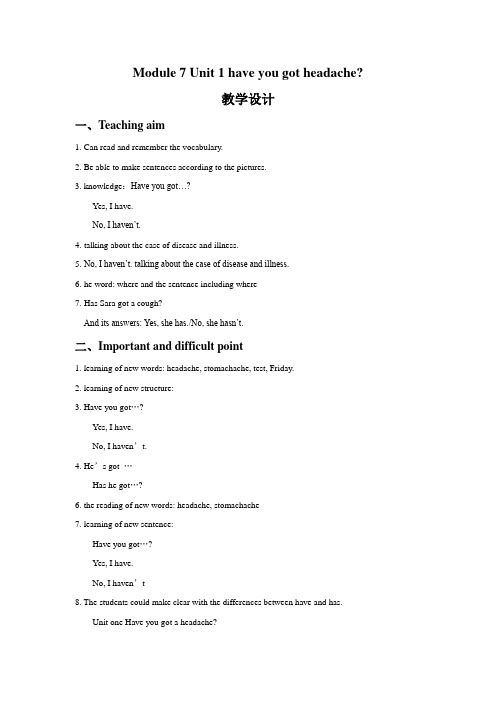
Module 7 Unit 1 have you got headache?教学设计一、Teaching aim1. Can read and remember the vocabulary.2. Be able to make sentences according to the pictures.3. knowledge:Have you got…?Yes, I have.No, I haven’t.4.talking about the case of disease and illness.5.No, I haven’t. talking about the case of disease and illness.6.he word: where and the sentence including where7.Has Sara got a cough?And its answers: Yes, she has./No, she hasn’t.二、Important and difficult point1. learning of new words: headache, stomachache, test, Friday.2. learning of new structure:3. Have you got…?Yes, I have.No, I haven’t.4. He’s got …Has he got…?6. the reading of new words: headache, stomachache7. learning of new sentence:Have you got…?Yes, I have.No, I haven’t8. The students could make clear with the differences between have and has.Unit one Have you got a headache?三、Teaching aidsRadio、cards、VCD、tapes四、Teaching processStep one: warming upGreeting and sing a chant in Module 4.Step two: RevisionFree talk between the teacher and the students.T : I’ve got an English book. What have you got?S1: I’ve got….S2: I’ve got…Step three: New teachingLearning of new sentence pattern:Have you got…?Yes, I have.No, I haven’t.The teacher can have a guess about what the students have got.The teacher turns back and every student prepares one thing and then the teacher asksthe students like the following:Have you got a pen?The students could answer with “Yes or no.”The teacher can lead students to answer like this:Yes, I have.No, I haven’t.The teacher continues to communicate with other students and then the teacher writes the following sentences on the blackboard.Have you got…?Yes, I have. No, I haven’t.Then the teacher can give the rights to the students and asks them to practice with theirpartners. Then the teacher teaches the new words: test, Friday. The teacher prepares one test paper and then asks students to what is this. The students could use the basic sentence: Have you got…? The teacher can fold the hand and say:Look, I’ve got a test paper. Then the teacher explains the Chinese meaning of test.The teacher communicates with students.Do you like tests?Here the students could talk about their own feelings about the test. The teacher shows one picture about the seven days in a week. And then the students are required to answer according to the real situation.五、Homework1. Read the dialogue and the sentence.2. Make a survey about health.。
最新外研英语一起三年级上册Module 7 Unit 1 教学课件
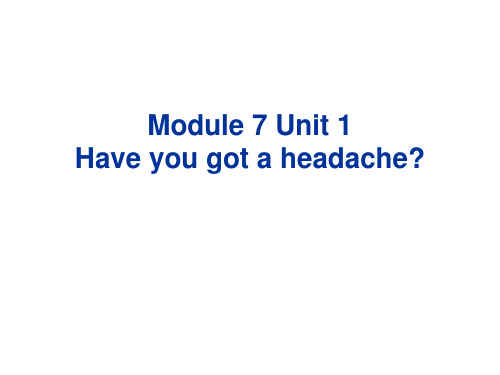
Don’t worry about the tests. You’re great children.
or
1.Sam is ill. 2.Sam has got a headache. 3.Sam has got a stomach ache. 4.Sam has got a test on Friday.
?
a
have ,
Yes . I
Share the information that you learned with your group members.
• Listen and read the text for 3 times.
2. Activity Book. Look and write in your group.
3. * Act the text with your partner.
Yes, I have. I’m tired.
Yes, I have. I’m hungry.
Yes, I have. I like tests.
No, I haven’t.
Have you got a headache? No, I haven’t. No, I haven’t. Have you got a stomach ache? No, I haven’t. No, I haven’t. Have you got a test? Yes, I have. Yes, I have. Don’t worry. Don’t worry. You are clever. Yeah!!!
Have you got a …? headache stomach ache test
- 1、下载文档前请自行甄别文档内容的完整性,平台不提供额外的编辑、内容补充、找答案等附加服务。
- 2、"仅部分预览"的文档,不可在线预览部分如存在完整性等问题,可反馈申请退款(可完整预览的文档不适用该条件!)。
- 3、如文档侵犯您的权益,请联系客服反馈,我们会尽快为您处理(人工客服工作时间:9:00-18:30)。
Module 7 Unit 1 have you got headache?
教学设计
一、Teaching aim
1. Can read and remember the vocabulary.
2. Be able to make sentences according to the pictures.
3. knowledge:Have you got…?
Yes, I have.
No, I haven’t.
4.talking about the case of disease and illness.
5.No, I haven’t. talking about the case of disease and illness.
6.he word: where and the sentence including where
7.Has Sara got a cough?
And its answers: Yes, she has./No, she hasn’t.
二、Important and difficult point
1. learning of new words: headache, stomachache, test, Friday.
2. learning of new structure:
3. Have you got…?
Yes, I have.
No, I haven’t.
4. He’s got …
Has he got…?
6. the reading of new words: headache, stomachache
7. learning of new sentence:
Have you got…?
Yes, I have.
No, I haven’t
8. The students could make clear with the differences between have and has.
Unit one Have you got a headache?
三、Teaching aids
Radio、cards、VCD、tapes
四、Teaching process
Step one: warming up
Greeting and sing a chant in Module 4.
Step two: Revision
Free talk between the teacher and the students.
T : I’ve got an English book. What have you got?
S1: I’ve got….
S2: I’ve got…
Step three: New teaching
Learning of new sentence pattern:
Have you got…?
Yes, I have.
No, I haven’t.
The teacher can have a guess about what the students have got.
The teacher turns back and every student prepares one thing and then the teacher asksthe students like the following:
Have you got a pen?
The students could answer with “Yes or no.”
The teacher can lead students to answer like this:
Yes, I have.
No, I haven’t.
The teacher continues to communicate with other students and then the teacher writes the following sentences on the blackboard.
Have you got…?
Yes, I have. No, I haven’t.
Then the teacher can give the rights to the students and asks them to practice with their
partners. Then the teacher teaches the new words: test, Friday. The teacher prepares one test paper and then asks students to what is this. The students could use the basic sentence: Have you got…? The teacher can fold the hand and say:
Look, I’ve got a test paper. Then the teacher explains the Chinese meaning of test.
The teacher communicates with students.
Do you like tests?
Here the students could talk about their own feelings about the test. The teacher shows one picture about the seven days in a week. And then the students are required to answer according to the real situation.
五、Homework
1. Read the dialogue and the sentence.
2. Make a survey about health.。
